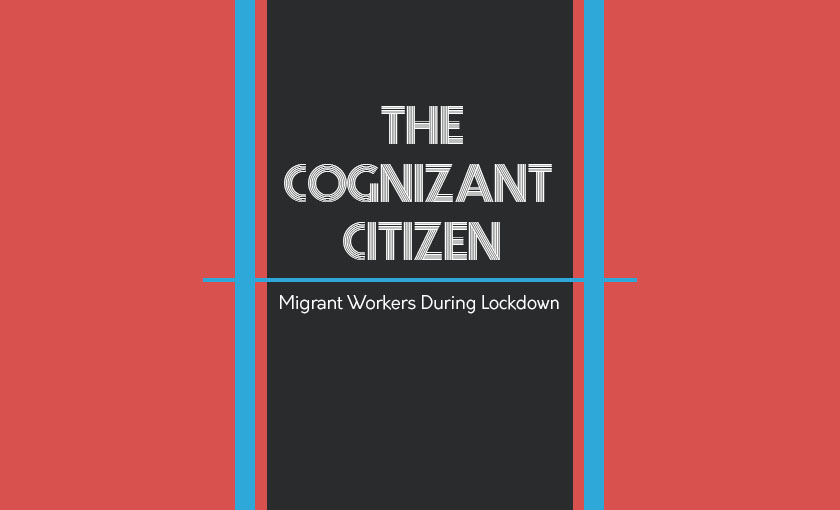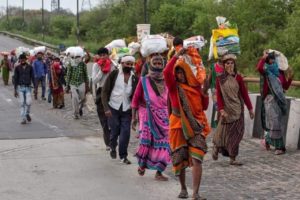
How does one define home? Perhaps a shelter over their heads, where they have a family, or where they earn a livelihood?
The need for some people to act as economic units and earn an income has displaced them from their homes. These people, better know as migrant labourers, constitute 37% of the workforce in India according to the census of 2011. The country’s infrastructure is built on the back of these workers. Be it street vendors, factory hands, delivery boys, domestic helpers or rickshaw pullers, migrant labourers can be found almost everywhere in the country today. This part of the labour force is also a disproportionate representation of the marginalized groups in the nation, mostly SCs and STs, which make up 25% of India’s population.
Considering the fact that this group of workers forms such a crucial part of the economy, it is unfortunate to see their plight in the ongoing pandemic situation. While Prime Minister Narendra Modi announced a lockdown in the country in order to prevent the spreading of COVID-19, he did not make any considerations or talk about the livelihoods of these migrant daily-wage labourers. These workers earn cash on a daily basis, and the lockdown impedes them from earning while at the job.
The night that the Prime Minister instituted the lockdown, the migrant workers started leaving Delhi, Mumbai, Kolkata, Bangalore etc., the cities where they work, because without an income, they can’t afford to live in these cities anymore. News reports said workers were stranded at railway stations. Some tried to flee in container trucks carrying essential commodities, but they were intercepted. This motivated them to start walking back home, first in a trickle, and then in masses. Through this mass movement, half a million people have vacated Indian cities to go back to their villages. At least 20 have died while trying to walk back home.
Voluntary organisations have set up soup kitchens and shelters for those on the move, but these were soon packed with people. Amid this chaos, tens of thousands of people flocked to the Anand Vihar-Kaushambi bus depot in New Delhi on the 28th of March, in hope of finding a bus to their respective hometowns and native villages. With this scale of influx, social distancing is a wild impossibility which puts the masses at a greater risk of being infected by the virus. Similarly, Mumbai’s Bandra West railway station was flooded with migrant labourers who were hoping to get back home as they expected the lockdown to end on the 14th of April; but now the lockdown has extended till the 3rd of May. The police had to resort to lathi-charge to disperse the crowd.
While some state governments are trying to provide for these migrant workers, it becomes important to understand that not every state in the country is equally equipped. The impact of the lockdown has indeed been the harshest on the migrant workers considering 62 percent of workers do not have any information about emergency welfare measures provided by the government and 37 percent do not know how to access the existing schemes. 40% of the migrant workers do not have any standard food supply. Several migrant workers also have debts to repay, which are an additional cause of anxiety without a steady stream of income.
ICRA has come out with a statement saying that the Indian economy will see a sharp contraction of 4.5% during Q4 FY20 which will eventually lead to a GDP growth of about 2% in FY21.
The main reasons for this is the slow down of imports from China which will have a direct impact on the domestic chain. The domestic impact of the pandemic can be seen in the slowdown in the domestic demand due to joblessness and pay cuts.
Considering the fact that 45.36 crore Indians (37%) in India are migrants (census 2011) the Indian government has tried to reduce the burden on the workers by announcing Rs1.7 lakh crore as relief.
The fear is that a large number of migrant workers who have fled the big cities may never return as they would prefer to earn a living out of farming and jobs in nearby towns. This will lead to a lack of labour in industrial cities such as Gurugram, Surat and Tiruppur which would further contribute to the situation of recession.
State governments have also stepped in to make sure that migrant workers receive the required help during the lockdown.
The UP, Bihar governments have ordered a mandatory 14-day quarantine for migrant workers returning to their villages.
The UP government has already transferred Rs 1,000 in the bank accounts of more than 30 lakh daily wage workers as financial assistance as ordered by CM Yogi Adityanath. Furthermore, the Uttar Pradesh government on Monday 6th deposited Rs 611 crore in the bank account of 27.5 lakh workers in the state under the Mahatma Gandhi National Rural Employment Guarantee Act (MNREGA) scheme.
The Delhi government announced that they will be converting schools in the Ghazipur area into night shelters to accommodate hundreds of migrant workers walking back home due to the coronavirus lockdown.
Meanwhile, the Kerala government has opened 4,603 relief camps that are housing 1,44,145 migrant labourers. Also, 35 camps have been opened for 1,545 homeless and destitute people, the CM announced. CM Pinarayi Vijayan said that food, masks, soaps, sanitisers have been made available in all those camps, and in the coming days, more educational institutions would be taken over.
During this lockdown and subsequent return of migrant workers from cities, we have also come across some disturbing news of workers being sprayed with disinfectant in UP. There have also been reports of migrant workers coming out on the roads in Surat, Gujarat demanding salaries and pleading with the authorities to let them go back to their natives.
With the recent announcement of the Prime Minister extending the nationwide lockdown to the 3rd of May with a possible relaxation from 20th April for areas that are less affected the hope is that at least a part of the workforce will be able to get back to working for shortened hours and initiate the countries move to normalcy.
- Written by Cynthia Maria Dsouza and Radhika Taneja for MTTN
- Featured image by Apurva Bandyopadhyay for MTTN
- Sources: Al Jazeera, India Today, Business Standard
- Image sources: Google images


Leave a Reply
You must be logged in to post a comment.